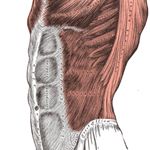
Core strength has caught on as buzz term in the fitness industry, although elite athletes and coaches have understood its value for years.
The biggest benefit of core training is to develop functional fitness, in other words, fitness that is essential to both daily living and regular activities.
Core strength refers to the muscles of the body’s trunk that stabilise the spine, pelvis and shoulders. It goes beyond just having strong abdominal muscles and includes the lower back. The muscles of the core make it possible to stand upright and move on two feet.
These muscles help control movements, transfer energy, shift body weight and move in any direction. A strong core distributes the stresses of weight-bearing and protects the back.
All athletic movements incorporate the core in some way. Powerful movements originate from the center of the body out and never from the limbs alone.
Core muscles act as shock absorbers for jumps and running on hard surfaces. Weak core muscles can lead to poor positioning of the spine associated with low back pain.
They are also vital for the transfer of energy from large to small body parts during many sporting activities, allowing for:
- Better efficiency of movement
- Improved body control and balance
- Increased power from both the core strength muscles and out through the shoulders, arms and legs
- Reduced risk of injury
- Improved balance and stability
- Improved athletic performance
Core strength training is different from other fitness workouts by working both the abdominal muscles and lower back in unison.
For a simple core strength program you can begin with push-ups and crunches, but work with a trainer to find the exercises that work best for you. Other exercises that develop core strength include exercises on a stability ball, work with medicine balls, wobble boards and Pilate’s exercise programs. Yoga is also an excellent way for athletes to build core strength.
Comments are closed.